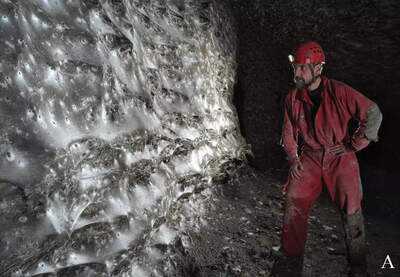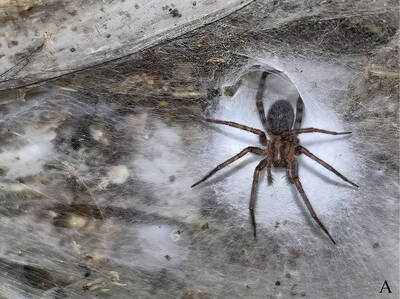In an astonishing discovery, scientists have found what is believed to be the world’s largest spiderweb inside Sulfur Cave , a dark and narrow passage located on the border between Greece and Albania. This extraordinary web, sprawling over a massive 106 square meters (1,140 square feet), is home to an estimated 111,000 spiders living together in an unprecedented colonial network.
The web, first discovered by cavers from the Czech Speleological Society during a 2022 expedition in Vromoner Canyon, is a remarkable patchwork of thousands of individual funnel-shaped webs clinging to the cave walls. A team of researchers led by István Urák from the Sapientia Hungarian University of Transylvania in Romania visited the cave in 2024 to study this extraordinary arachnid colony.
The colony comprises two dominant species: about 69,000 individuals of Tegenaria domestica, commonly known as the barn funnel weaver or domestic house spider , alongside more than 42,000 Prinerigone vagans, a type of sheet weaver spider. This is the first documented instance of these two common species exhibiting cooperative colonial behavior instead of their usual solitary or predatory interactions.
Spiderweb discovery reveals massive spider colonies : In photos



Sulfur Cave spiders thrive in a unique Sulfur-powered ecosystem
According to the researchers, the absence of light within Sulfur Cave appears to have altered normal spider behaviors, potentially disrupting predatory instincts and allowing these species to coexist in such high densities. The cave environment is uniquely sustained by a sulfur-rich stream flowing through the cavern, producing hydrogen sulfide that supports a sulfur-based microbial biofilm ecosystem.
The spiders’ primary diet consists of non-biting midges, which feed on these microbial films, creating a fascinating sulfur-driven food web that sustains the massive spider colony. This cave ecosystem is unlike any other, as molecular and gut content analyses reveal that the cave-dwelling spiders have genetically diverged from their surface relatives and possess less diverse microbiomes due to their sulphur-based diet.
The cave is also a hotspot for reproduction, with female house spiders known to lay six to eight egg sacs every 20 to 25 days, each containing up to 100 eggs in the first cocoon, followed by smaller successive clutches. The density of the webs makes it impossible to count all the egg sacs precisely.
“The moment of discovery inspired admiration, respect, and gratitude,” said lead author Urák, emphasizing the uniqueness and ecological importance of this find. The research team is now preparing for further studies to better understand the web’s ecology and the adaptations of its arachnid inhabitants. Conservation of this site remains a priority, given its fragile and isolated nature.
This groundbreaking discovery sheds light on how species adapt within extreme environments and reveals a hidden biodiversity hotspot demonstrating remarkable biological cooperation and survival.
The web, first discovered by cavers from the Czech Speleological Society during a 2022 expedition in Vromoner Canyon, is a remarkable patchwork of thousands of individual funnel-shaped webs clinging to the cave walls. A team of researchers led by István Urák from the Sapientia Hungarian University of Transylvania in Romania visited the cave in 2024 to study this extraordinary arachnid colony.
The colony comprises two dominant species: about 69,000 individuals of Tegenaria domestica, commonly known as the barn funnel weaver or domestic house spider , alongside more than 42,000 Prinerigone vagans, a type of sheet weaver spider. This is the first documented instance of these two common species exhibiting cooperative colonial behavior instead of their usual solitary or predatory interactions.
Spiderweb discovery reveals massive spider colonies : In photos
Sulfur Cave spiders thrive in a unique Sulfur-powered ecosystem
According to the researchers, the absence of light within Sulfur Cave appears to have altered normal spider behaviors, potentially disrupting predatory instincts and allowing these species to coexist in such high densities. The cave environment is uniquely sustained by a sulfur-rich stream flowing through the cavern, producing hydrogen sulfide that supports a sulfur-based microbial biofilm ecosystem.
The spiders’ primary diet consists of non-biting midges, which feed on these microbial films, creating a fascinating sulfur-driven food web that sustains the massive spider colony. This cave ecosystem is unlike any other, as molecular and gut content analyses reveal that the cave-dwelling spiders have genetically diverged from their surface relatives and possess less diverse microbiomes due to their sulphur-based diet.
The cave is also a hotspot for reproduction, with female house spiders known to lay six to eight egg sacs every 20 to 25 days, each containing up to 100 eggs in the first cocoon, followed by smaller successive clutches. The density of the webs makes it impossible to count all the egg sacs precisely.
“The moment of discovery inspired admiration, respect, and gratitude,” said lead author Urák, emphasizing the uniqueness and ecological importance of this find. The research team is now preparing for further studies to better understand the web’s ecology and the adaptations of its arachnid inhabitants. Conservation of this site remains a priority, given its fragile and isolated nature.
This groundbreaking discovery sheds light on how species adapt within extreme environments and reveals a hidden biodiversity hotspot demonstrating remarkable biological cooperation and survival.
You may also like

UPS plane crash: Experts reveal 7 possible reasons why Kentucky cargo jet burst into flames

CITES Urges India to Halt Wild Animal Imports: What's Behind the Recommendation?

After 'Dhoom Machale' song in NYC victory speech, Mamdani's old 'dune machale' tweet goes viral

'Halloween fireballs' and their threat to 2032 and 2036: Could the taurid swarm endanger Earth

US services gain in October even as jobs stay weak







